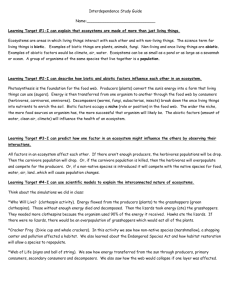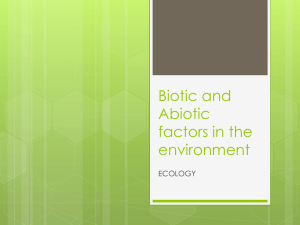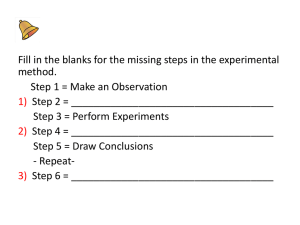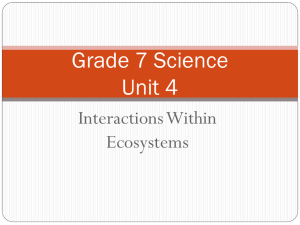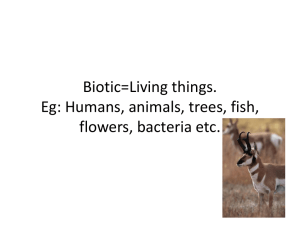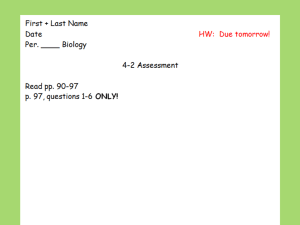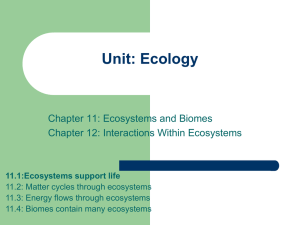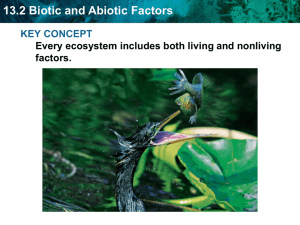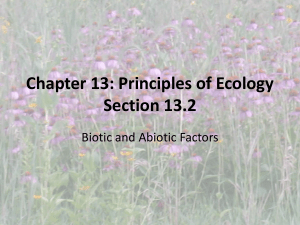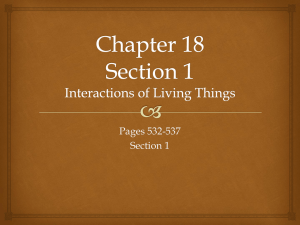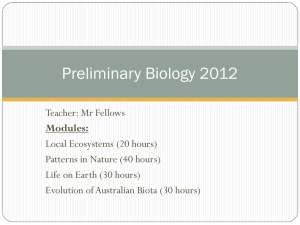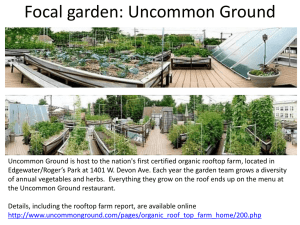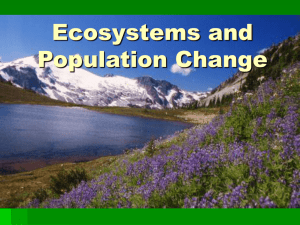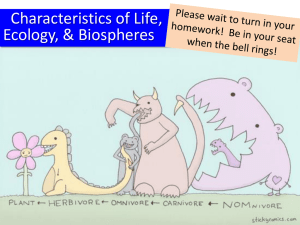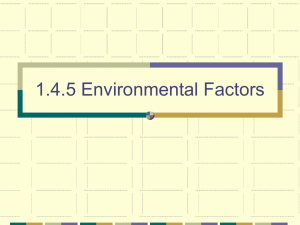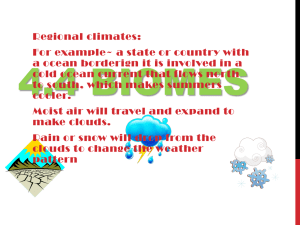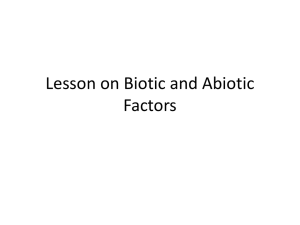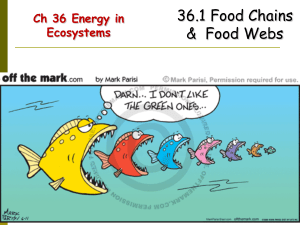chapter 1 ppt
advertisement
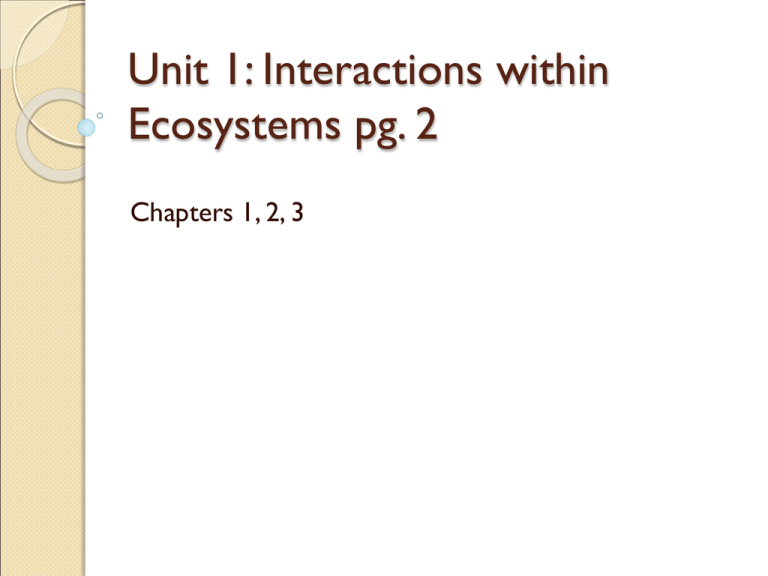
Unit 1: Interactions within Ecosystems pg. 2 Chapters 1, 2, 3 Getting Started pg. 4 Ecology ◦ “eco” means “home” in Greek ◦ “ology” means “the study of” ◦ Is the study of our home Earth which includes living things and how they interact with their surroundings. What is an Ecosystem? Local Area : Pond, Meadow, Wetland, River, Forest, Coastline Living Things Local Conditions Chapter 1: Ecosystems pg. 6 Ecosystem ◦ Is a place that includes all the living and nonliving things ◦ Living things are called “biotic factors” ◦ Nonliving things or conditions are called “abiotic factors” ◦ Interaction exists between biotic and abiotic factors ◦ Ex: coastlines, oceans, rivers, lakes , ponds, arctic, forests 1.1: Types of Ecosystems pg. 8 Organisms: - are examples of living things - are found in all ecosystems - have adaptations which are inherited characteristics that help an organism survive and reproduce - have specific habitats ex. Bacteria, salmon, duck, arctic hare, fox Ex. Arctic Hare Adaptations: ◦ Are inherited characteristics that help an organism survive and reproduce. ◦ Ex. Big ears, big front teeth, strong hind legs, coat color Habitat Is the particular place where an organism lives ◦ Ex. Arctic hare live in arctic, barrens and forests Organism Moose Whale Fox Frog Balsam Fir tree Blueberry Bush Butterfly Adaptation Habitat Abiotic Factors Sunlight Rain Soil Abiotic Factors Are nonliving parts of an ecosystem Biotic Factors Are the living parts of an ecosystem Include all the organisms present and their “niche”(role an organism plays in its ecosystem). Organisms Predation Competition Competition Symbiosis : Commensalism Symbiosis: Parasitism Symbiosis: Mutualism 1.1: Ecosystems in Atlantic Canada pg. 8 1. 2. Coastlines and Oceans Freshwater • rivers • lakes • ponds 3. 4. Arctic Forest Ecosystems in Atlantic Canada pg. 10 1. Coastlines and Oceans Where the Atlantic Ocean meets the land Biotic factors: ◦ Organisms : seaweed, barnacles, mussels, starfish, rock crabs, fish, seals whales, jellyfish, plankton, tuckamore ◦ Niche : where does each organism live? How does it get its food? How does it affect the environment? Burnt Island Cape St. Mary’s Middle Cove Beach Touch Tank : Logy Bay Tuckamore Biotic Factors of Deep Ocean Abiotic Factors of Coastlines and Oceans 1. Light and light intensity ◦ Penetrates to 200m 2. Temperature ◦ From -1C to 10 C 3. Soil ◦ Mostly rocky, some sandy beaches 4. Air and wind ◦ Air is humid, strong sea breezes, lots of fog 5. Water ◦ Lots of waves, salty, tides, currents 2. Freshwater Ecosystems Rivers, lakes ponds Rennies Mill River, Windsor Lake, Hughs Pond Abiotic Factors Biotic Factors 3. Arctic Forests Mainly coniferous trees which keep their leaves all year long Grow well in acidic soil can survive long cold winters Biotic Factors Coniferous trees Deciduous trees Moose Caribou Fox Hare Black bears Lynx Pine marten Abiotic Factors Peat Blanket bogs Cool summers Wet winters 1.2 Abiotic Parts of Ecosystem pg. 16 Range of Tolerance - range of conditions within which an organism can survive. Precipitation and Living Organisms Water Temperature and Turbidity Ph of Water Air Temperature and Plants Temperature and Tree Growth Wind and Tree Growth Light and Light Intensity Soil ph and Plants Interactions Between Abiotic and Biotic factors: a. Abiotic – Abiotic Ex. Sunlight evaporates water b. Biotic – Abiotic Ex. Worms aerate soil c. Biotic – Biotic Ex. Insects eat plants Biotic Parts of an Ecosystem pg. 24 Species : – refers to a group of organisms that can reproduce among themselves to produce offspring of the same type that can also reproduce successfully. ex. Moose, caribou, trout, salmon, fox, pine marten Levels of Organization a. Individuals – one member of a specific species ex. goose b. Population – includes all the members of the same species that live together in one ecosystem at the same time. ex. Flock of geese c. Community Includes all the populations that live together and interact with each other in the same ecosystem Ex. Geese, ducks, rabbits, moose, frogs all living next to a pond. Niche Includes the role of a species plays in an ecosystem which includes: ◦ ◦ ◦ ◦ Where it lives How it gets food How it affects the environment How it interacts with other organisms What is the role of the mushrooms? What is the role of the eagle? What is the role of each plant?


